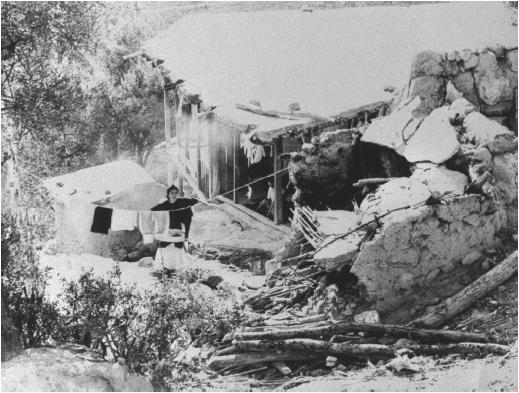And Life Goes On - Film (Movie) Plot and Review
(Zendegi Edame Darad; Life and Nothing More)
Iran, 1992
Director: Abbas Kiarostami
Production: Institute for the Intellectual Development of Children and Young Adults; color, 35 mm; running time: 91 minutes (95 in Iran; 108 in Canada); sound: mono. Filmed in Koker and Poshteh, Iran.
Producer: Ali Reza Zarrin; screenplay: Abbas Kiarostami; cinematographer: Homayun Payvar; editor: Abbas Kiarostami; assistant director: Hassen Afakrimi, Alirfa Akbari, Behram Kadhemi; production supervisor: Nemet Allah Yahifi, Khada Dad Ahmed, Mahrem Fifi; production manager: Sadika Sarfrazian; costume design: Hassan Zahidi; artistic supervisor: Ferched Bachirzada, Djalil Chaabani, Saad Saidi; sound: Abbas Kiarostami, Djenkis Sayed.
Cast:
Farhad Kheradmand (
Film Director
); Buba Bayour (
Puya
); Hocine Rifahi; Ferhendeh Feydi; Marhem Feydi; Bahrovz Aydini; Mohamed
Hocinerouhi; Hocine Khadem; Maassouma Berouana; Mohamed Reda Berouana;
Chahrbanov Chefahi; Youssef Branki; Chahine Ayzen; Mohamed Bezdani; and
others.
Publications
Articles:
Libiot, Eric, review in Première (Paris), November 1992.
Ångström, Anna, "Livet efter katastrofen," in Svenska Dagbladet (Sweden), 3 June 1994.
James, Nick, review in Sight and Sound (London), October 1996.
* * *
And Life Goes On is the middle film of a trilogy, preceded by Where Is the Friend's Home? and followed by Through the Olive Trees. The three films (rightly regarded as among the great achievements of contemporary world cinema) are intricately interconnected; only the first might be considered self-sufficient. Briefly, Where Is the Friend's Home? is a straightforward neo-realist film about the predicament of two small boys in an adult world too preoccupied with its own problems to listen to children. And Life Goes On is set in the same district of Iran a year or so later: the great earthquake has intervened, and the director of the first film (played by an actor, and never named within the film) journeys by car with his young son to find out whether the two children who acted the main roles in the previous film have survived. Through the Olive Trees carries the self-reflexiveness even further, at times into quite dizzying convolutions: Kiarostami (played this time by a different actor, though now named) returns again to the area to make a film about the filming of And Life Goes On , partly involving the reconstruction of scenes from that film; at one point, then, we have Kiarostami himself (off screen) directing an actor playing Kiarostami directing the actor who played him in And Life Goes On. With this in mind, it may seem paradoxical to add that the most obvious characteristic of Kiarostami's films is their simplicity. The complications are in the material, never in its filmic realization. If one also wishes to describe his filmmaking as virtuoso, that is again not really a contradiction: the music of Mozart (with which Kiarostami's work, in its emotional delicacy and complexity, might be felt to have an affinity) might also be described as at once simple and virtuosic. Consider, for example, the now famous last shots of both And Life Goes On and Through the Olive Trees , the moments often referred to as "epiphanies": what could be simpler than simply placing the camera in the necessary viewing position and refusing to move it or cut throughout a lengthy action shown in extreme long-shot? And the action itself is as simple as possible: a car trying to climb a steep hill, a young man running to catch up with the woman he loves to propose one last time. Yet the suspense is edge-of-your-seat, the end a whole new beginning, such is the emotional investment asked of the spectator.
Kiarostami's aesthetic roots are in Italian neo-realism (one notes a particular affinity with the greatest of the neo-realists, making it especially appropriate that he was given the Rossellini prize at an Italian film festival). The self-reflexivity comes perhaps from the French New Wave, especially Godard, though it seems so natural to Kiarostami, to arise so logically from his work, that one wonders whether he invented it independently. Where Is the Friend's Home? never calls its (fictional) reality into question. And Life Goes On remains faithful to the basic neo-realist principles, with everything shot on location using non-professional actors ("real people"), yet it is also the interrogation of neo-realism: the figure of the filmmaker now appears in the film, the previous film is revealed as a film, a fiction, and the "real people" were in fact acting: one of them, encountered en route, complains that Kiarostami made him dress and behave quite differently from his everyday self. We are of course free to ask whether Kiarostami told him to say this, especially in retrospect from Through the Olive Trees , in which we see the director insist (against all odds) that the recalcitrant actors speak the lines they have been given.
Yet the levels never cancel each other out. If we are aware of a dislocation between fiction and reality, we are also constantly aware

—Robin Wood
Comment about this article, ask questions, or add new information about this topic: